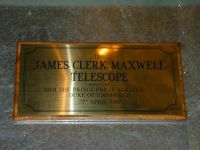
A Visit to the
James Clerk Maxwell Telescope
(JCMT)
on top of Mauna Kea, Hawaii, October 2002
The JCMT currently is the largest Radio telescope dedicated to millimeter
and submillimeter radio astronomy. The range of frequencies covered extends
from 0.3mm to about 2mm. The receiver dish has a diameter of 15m and consists
of 276 individually adjustable aluminum panels that give it the near perfect
parabola shape needed to image the sky in radio waves. The dish is supported
by a massive truss support structure that minimizes flexure of the dish
when moving across the sky. The moving mass of the telescope is about 70
tons which is tracking the Sky in sub arc second accuracy.
To protect against the elements the dish is mounted inside a free rotating
dome which is seismically isolated from the telescope mount. A giant Gore-Tex
membrane covers the dome opening. The material is totally (97%) transparent
in the radio spectrum and does not interfere with the observation. So the
telescope is conveniently protected from wind, rain and dust. It also allows
observations very close to the sun or the sun itself. Otherwise the sun
would be reflected from the dish and burn the receiver electronics.
Click on the pictures
to see a larger version:
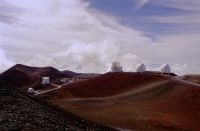 |
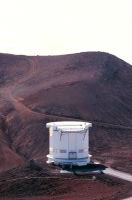 |
The JCMT (second dome from the left) on its site
on top Mauna Kea at an elevation of 4092m (13425 ft).
On the upper right the Subaru telescope and the domes
of the two Keck telescopes (all optical telescopes) |
JCMT |
To receive mm and sub-mm radio signals the observer has to eliminate
water vapor which strongly absorbs the radiation in these wave lengths.
High mountain tops with dry air allow the telescope to be above 97% of
all water vapor that is in the atmosphere.
Still a lot of the radiation is absorbed by water molecules in the
high atmosphere leaving only a set of 'radio windows' available for the
observer. Luckily a lot of scientifically rewarding observation can be
made in those windows. Beyond that only very expensive space observatories
can detect signals outside these windows.
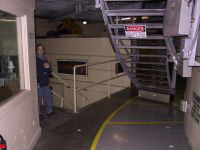
The telescope mounting is structurally separate from the telescope dome.
The yellow line in the ground marks the gap. This prevents vibrations from
movements of the dome as from wind loads to be transferred to the telescope
which is held perfectly pointed to the celestial object under study.
 |
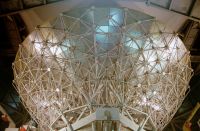 |
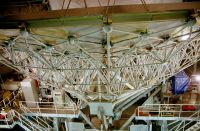 |
| The massive telescope mounting. |
The whole dish. |
Detail of the support structures for the 276 panels that make up the
reflector dish. |
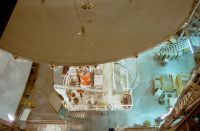 |
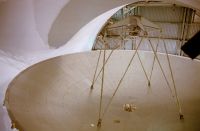 |
 |
| View from the top of the dome onto the dish. |
The protective Gore-Tex membrane curves around the telescope on the
left. |
The entire dish under the Gore-Tex screen. |
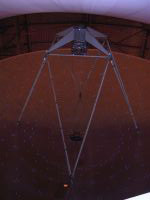
A flash light picture shows reflections from the alignment bolts of
the dish. A high tech view!
Each of the radio windows in the atmosphere is matched with a dedicated
receiver at the JCMT. As the signals from space are in a spectral range
where the heat of the telescope itself contributes to background noise
special techniques are necessary to detect the signals. At first the detectors
itself are cooled to nearly absolute zero using liquid helium cooling.
(4K)
Next the telescope's secondary mirror can quickly switch between the
object under study and nearby blank sky. The difference is then the desired
signal from the object.
A major contribution in recent years have been the evolution of receiver
technology. When previously the detector (a bolometer) only registered
radiation from one signal spot of the sky (1 pixel!). New technologies
borrowed from semiconductor manufacturing allow the use of small detector
arrays. These are only a few tens to hundred pixels, much less than what
is available for optical astronomy, but still a great improvement from
before. With those array detectors larger areas of the sky can now be observed
using a rastering methodology.
Object of interest in the mm and sub-mm radio astronomy are mostly
interstellar dust and molecules. A map of the central portion of the milky
way is depicted below.

Image: JCMT
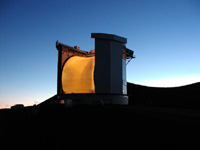 |
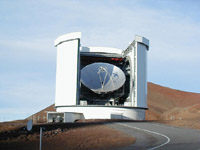 |
From the archive of the JCMT.
The dome is opened for observing.
Light from the inside illuminates the
Gore-Tex membrane. |
Also from the JCMT archives. The dish
is openly visible. The Gore-Tex membrane
was rolled up during repair work in September
2000. |
The three last images with kind permission from the JCMT archives.
All other images made by Sibylle Fröhlich and Gert Gottschalk
on October 4th 2002. We would like to thank Bernd Weferling from
JCMT for the guided tour.
S. Fröhlich,
G.
Gottschalk, Oktober 2002



